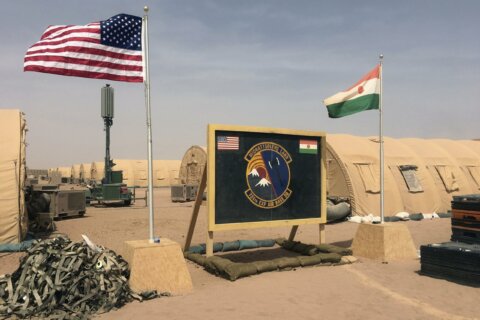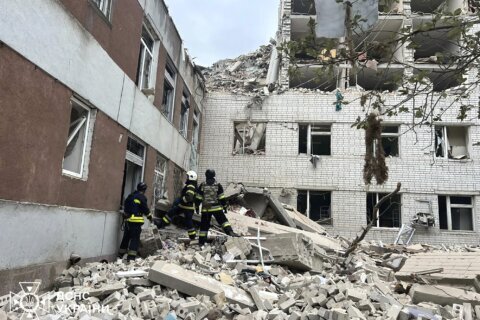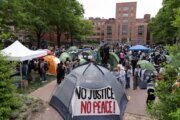WASHINGTON — In the shadows of the fighting between Ukrainian military forces and Russian-backed rebels in eastern Ukraine, potentially deadly radiological material has allegedly been removed from an underground bunker.
Ukrainian security service documents surfaced in early August suggesting the rebels and Russian scientists were working on a radiological dispersal device (RDD) –better known as a dirty bomb. The Russian government has since pointed the finger at Ukrainian forces.
But U.S. officials and international experts fear a far greater threat looms.
“We’re very much concerned about the Islamic State in Iraq and the Levant (ISIL) or Al Qaida trying to steal radioactive material and make a dirty bomb that can be used either in the region or theater, or transported elsewhere and then used to create massive damage and havoc,” said Andrew Bieniawski, Vice President, Material Security and Minimization with the Nuclear Threat Initiative (NTI).
Both terror groups have established operatives in the region. Al Qaida’s Caucasus Emirate began operations in 2007, but recently some of its fighters defected to ISIL.
A U.S. defense official told WTOP in July, a new ISIL affiliate had begun operation in the late spring and early summer. On June 23, 2015, Russian-speaking militants in the North Caucasus appeared in an ISIL propaganda video pledging allegiance to ISIL.
“The reports from Ukraine of Russian rebels perhaps making a dirty bomb are indeed very disturbing. But what this really does is highlight the need to secure these vulnerable radiological sources all around the world,” Bieniawski said.
Moving the material, creating weapons and attacking large population centers is of great concern.
Robin Simcox, Research Fellow at the London-based Henry Jackson Society, has spoken to security and intelligence officials in the U.K. who have been quietly wrestling with the threat of a dirty bomb detonation since shortly after the 9/11 attacks.
“It’s a problem we’ve been facing in the U.K. for some time now. There was a plot back in 2004 by some Al Qaida-inspired individuals planning to put together a dirty bomb and looking at places where they could detonate it, like a nightclub or football stadium – where they could maximize the impact.”
Radiological material produced artificially in nuclear reactors and accelerators are widely available, including cesium-137, cobalt-60, iridium-192, and strontium-90, which are used in hospitals to treat cancer through radiotherapy and also to treat blood disorders.
A 2012 U.S. Government Accountability Office report said, “Radiological materials used for certain diagnostic purposes, such as diagnostic imaging, have low levels of activity and do not present a significant safety or security risk. However, high-risk sealed radiological sources that contain cobalt-60, cesium-137 or iridium-192, could pose a greater threat to the public and the environment and could also pose a potentially more significant security risk, particularly if acquired by terrorists to produce a dirty bomb.”
According to Bieniawski, there are literally thousands of these sources in more than 100 countries around the world. Locations inside those countries include hospitals in war-zones and may be under the control of jihadist organizations.
His primary fear is “attack by terrorists intent on stealing the material to make a radiological dispersal device (RDD), better known as a dirty bomb.”
“The concern now,” said Bienawiski, “is that we don’t really know what the level of security is in Ukraine. You have uncontrolled territory in Ukraine. Many of these facilities that have materials can be easily accessible because they are used provide medical treatment and patient care and might not have the highest security.”
While worry over the missing material in Ukraine has dominated the headlines, the danger in war-torn parts of Syria and Iraq is profound.
Anxiety over dirty bombs comes on the heels of allegations that ISIL has used chemical weapons against Kurdish fighters in Iraq in recent weeks. “I’ve seen those reports and we continue to take any allegations of chemical weapons use very seriously. Lots of different terrorist groups are attempting to obtain some type of chemical weapon,” said Col. Pat Ryder, spokesman for U.S. Central Command.
The defense official WTOP spoke to in July said ISIL operatives have engaged in beheadings, drownings, and caged-burnings; and new recruits seem to be looking for even more violent means of attacking targets.
Simcox said, “ISIL would be happy to use the most devastating weapon it could get its hands on; it’s as simple as that.”
“We have to be aware of changing circumstances and we are very concerned about the situation in Iraq and Syria and the territory that ISIL has control over, so we want to make sure these sources are secured to the extent that we have access to them and can lock them up,” Bieniawski said.
There is a widespread, well-funded international effort supported by NTI to try and secure those elements, but intelligence sources tell WTOP, there is little chance that civilians or militarized units can safely penetrate ISIL territory to secure radiological sources that may be at risk.
According to Bieniawski, “Unlike the skills needed to make a nuclear weapon or even an improvised nuclear device there is not a high level of skill required to make a dirty bomb.”
Bieniawski said, detonating a dirty bomb might not inflict a heavy death toll, depending on how it’s deployed, but it would have a significant impact on human life.
“A dirty bomb”, he said “could leave tens of millions of dollars in damage due to the massive costs of evacuation and relocation and clean-up. These dirty bombs are really called weapons of mass disruption as opposed to weapons of mass destruction.”







